#mushroom hunting
Text

mgts | arts & hobbies
#hats#mushroom hunting#fungi#fantastic fungi#mycology#mushrooms#forest photography#fungus#fungiphotography#wild fungi#so many notifications#stupid hat
31K notes
·
View notes
Text

#moss#mosscore#mossy thoughts#moss aesthetic#nature#naturecore#mushrooms#mushroom hunting#fungi#fungus#wild fungi#found in the wild#in the woods#in the forest#slow living
952 notes
·
View notes
Text
I am all for creative sushi, but not when the creator doesn't fully understand the ingredients. A sushi restaurant in Montana served people sushi with raw and very undercooked morel (Morchella spp.) mushrooms on it. Over fifty people ended up sick with gastrointestinal upset, and two people actually died. Other restaurants that served the same batch of morels, fully cooked, had no such issues, and there was no evidence that there was any mishandling of the morels that could have caused a bacterial or other contamination. So it's pretty clear that the raw morels themselves were to blame.
Yes, there are a few wild mushroom species you can eat raw, and only in small amounts). No, Morchella are not among them. Morels have a toxin in them that's neutralized by cooking; Paul Stamets theorized that it's hydrazine, but no one has been able to isolate hydrazine in a morel yet so that's not a done deal. Whatever it is, there's enough of it that it tends to give people nasty gastrointestinal upset when they eat raw morels, even in small quantities. This is the first I've heard of people dying from it.
It's not the only time I've heard of people dying from consuming a commonly-considered-edible mushroom, though. There were two separate incidents--2004 and 2009--in which several people who ate angel wing mushrooms (Pleurocybella porrigens) died of encephalopathy. Now, it did turn out that most of the people sickened had pre-existing liver and/or kidney issues. And a 2011 study identified an unstable amino acid, now named Pleurocybellaziridine, as the possible fatal factor that was found in large quantities in angel wings. It could be that the culprits were flushes of these mushrooms with abnormally high amounts of Pleurocybellaziridine. But you can't tell how much of a given metabolite a given mushroom has just by looking at it, and so that raises enough of an alarm for me personally that as a forager I just put angel wings on the "do not eat" list.
Will I continue to eat morels? Yes. The toxicity associated with raw morels has been known for a long time, and there have been no recorded issues with thoroughly cooked morels (the angel wings were also cooked, meaning the toxin is not thermolabile.) And as mentioned before, almost any edible wild mushroom is going to give you gastrointestinal issues if you eat it raw. The mushrooms you get at the store are a weird outlier that can be safely eaten raw. And by the way, button mushrooms, criminis, and portobellos are all the same species--Agaricus bisporus--at different stages of development.
This is why I emphasize in my foraging classes that you should always cook your wild mushrooms thoroughly, and if you're trying a new species for the first time only eat a small amount and then wait a few days to make sure you don't have any reactions. As the saying goes, there are old mushroom hunters and there are bold mushroom hunters, but there are no old, bold mushroom hunters.
#mushrooms#mushroom hunting#mushroom foraging#foraging#edible mushrooms#morels#Morchella#fungi#fungus#mycology#poisonous mushrooms#nature#food#foragers#wild mushrooms#sushi#Montana#food safety
1K notes
·
View notes
Text



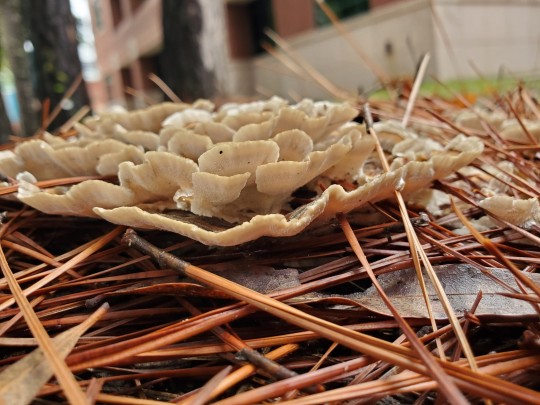

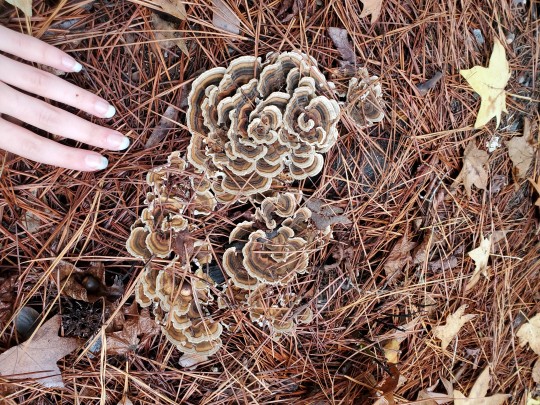
Turkey tail 》 Trametes versicolor
A beautiful flush of turkey tails! It's so cool to see how they grew around the pine needles.
Southeast Texas, 13 Nov. 2023
#amatuer mycology#mushroom hunting#mushrooms#mycology#wild fungi#fungi#mushrooms of texas#texas mushrooms#fungi of texas#fungarium#wild mushrooms#mushroom#mushroom identification#special interest#foraging#turkey tail#trametes versicolor
339 notes
·
View notes
Text
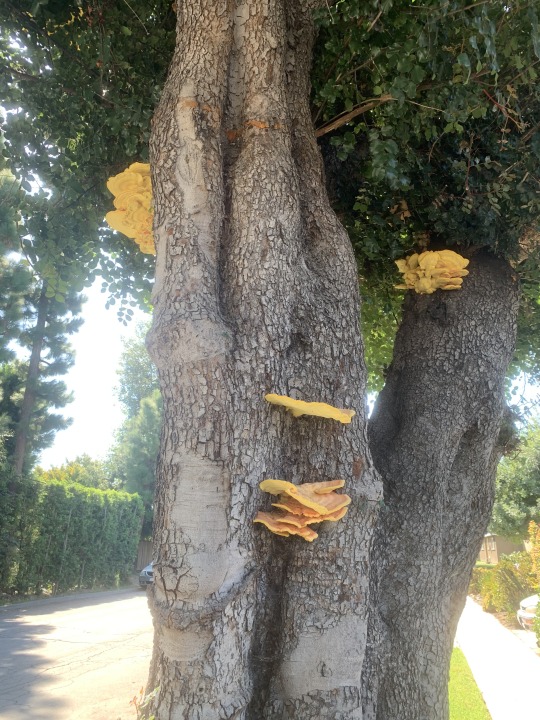
I finally harvested from my Chicken of the Woods (Laetiporus gilbertsonii) spot. I come back every year around the same time and had been keeping an eye on it since I started seeing little yellow blobs emerging from the tree. They start off really soft and gummy before flattening out into firm brackets. Basically the lower brackets are the perfect size to harvest. Some of the higher brackets still have room to grow so I might return for more later. This species marks the beginning of fall & the return of mushroom season in SoCal
#chicken of the woods#socal#laetiporus gilbertsonii#mushroom hunting#mushrooms#mushroom#fungus#fungi#mycology#fall
250 notes
·
View notes
Text

Cambridge, UK, October 2023
Yellow staghorn fungus (Calocera viscosa)
I always find these pretty little things are more orange than yellow when young, then their colour pales a little as they mature.
168 notes
·
View notes
Text
Lomwé and Macua communities in Mozambique’s Zambezia province traditionally harvest wild mushrooms to eat alongside staples like cassava. Conservationists are working with hundreds of indigenous women there to commercialize the sale of mushrooms like the vivid orange Eyukuli (Cantharellus platyphyllus) as part of a wider strategy to protect forests surrounding Gilé National Park.
The mushrooms are harvested in a 55,600-hectare (137,400-acre) buffer zone surrounding the national park during the height of the Southern African country’s wet season, from November to April. After harvesting, the fungi are cleaned, dried, and transported by road to Maputo, the capital, more than 2,000 kilometers (1,200 miles) away. There, they’re packaged and sold under the trade name Supa Mama.
This is the first time that native Mozambican mushrooms have been commercialized in the country.
Gilé covers an area of 286,100 hectares (707,000 acres), much of this covered in miombo woodlands that include tree species, like those from the Brachystegia genus, whose roots host mycorrhizal fungi. These underground networks help the trees absorb nutrients and moisture, and announce their presence in the form of diverse fruiting bodies above the ground: mushrooms.
Providing an economic incentive to protect the trees could be key to leaving them standing while promoting the wild mushroom harvest, says Alessandro Fusari...
Communities living around Gilé harvest at least 46 species of mushroom for local consumption. These include eyukuli, the trumpet-shaped khaduve (Lactifluus edulis), and the broad-capped namapele (Lactarius densifolius). So far, a total of five species are being harvested and packed for commercial sale under the project.

Pictured: Cantharellus platyphyllus (called Eyukuli in Lomwé) is one of 46 wild mushroom species Indigenous women harvest.
“Slowly, the community, especially the women, are learning that keeping the trees standing means having a bigger production of mushrooms,” Fusari tells Mongabay. “Since they’re starting to see commercial results, more and more avoid cutting trees.”
The project, which is supported by the French Development Agency, is in its third year, meaning the team doesn’t yet have the hard data to determine its success. But, Fusari says, the reduction in tree cutting “is a clear trend that is happening.”
Mushroom harvesting around Gilé is typically done by women while out doing other tasks, such as gathering firewood. The mushroom project works with 900 or so members of 30 women’s groups drawn from communities living in the national park’s buffer zone.
Gilé National Park is home to animals that include buffalo, wildebeest, sable, waterbuck, and around 50 elephants. Many of these animals were reintroduced from other areas to rebuild the wildlife wiped out during Mozambique’s 1977-1992 civil war.
...Giving commercial value to something normally only collected for subsistence is part of a wider program to promote sustainable agriculture...
The teams collecting mushrooms have already been trained in sustainable harvesting methods. For instance, they cut rather than pull the mushrooms from the ground, to avoid damaging the mycelium, or root-like structure, beneath the surface; they brush the dirt off the mushrooms wherever they pick them, to leave as many spores there as possible; and the women carry their harvest home in open baskets, to allow spore dispersal along the way.
-via Good News Network, October 14, 2023. Based on reporting by Mongabay News, September 1, 2023.
#mozambique#mozambican#conservation#sustainability#national park#forest#forest conservation#mushrooms#fungi#wild fungi#mycorrhizal fungi#mycorrhizal network#sustainable agriculture#agriculture#good news#hope#mycelium#mushroom hunting#mycology#deforestation#also very cool info about sustainable mushroom harvesting tbh
220 notes
·
View notes
Text

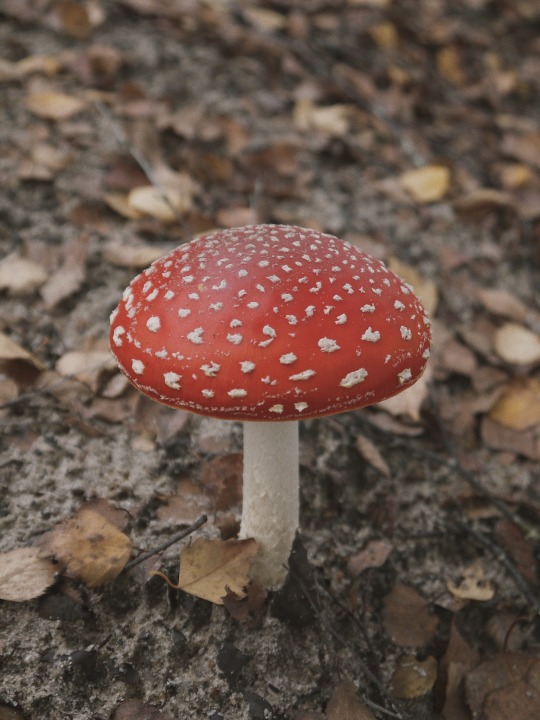
mushroom season is the best season 🍄🤎
#mine#slow living#countryside living#cabincore#cabinblr#slow life#old style#a quiet style#rustic#mushrooms#mushies#mushroomcore#mushroom hunting#autumn countryside#autumn#autumnblr#fallblr#fall vibes#nature photography
1K notes
·
View notes
Text


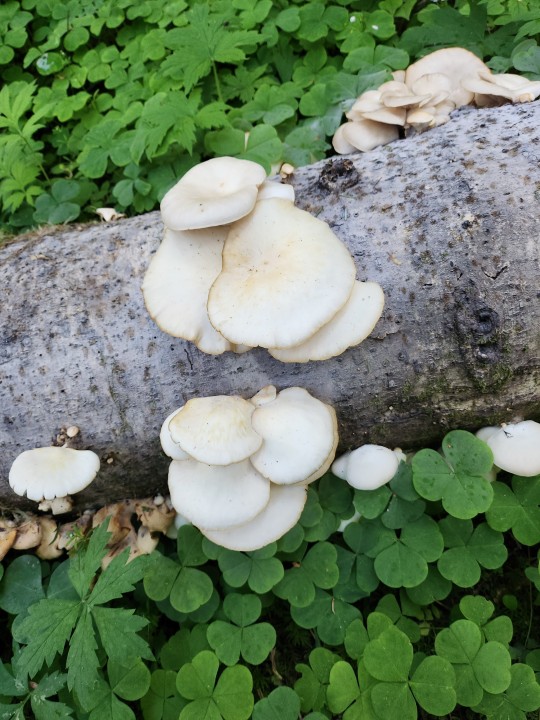
Oyster mushrooms (Pleurotus ostreatus)
These shrooms are one of my favorites to forage and eat. They are delicious and can be cooked in several different ways.
These shrooms aren't just yummy. They are CARNIVORES. Oyster mushrooms prey on nematodes by releasing a toxin that paralyzes and causes necrosis in their tiny victims. The nematodes are eventually reduced to a sludge that is easily digested by the oyster mushrooms.
116 notes
·
View notes
Text



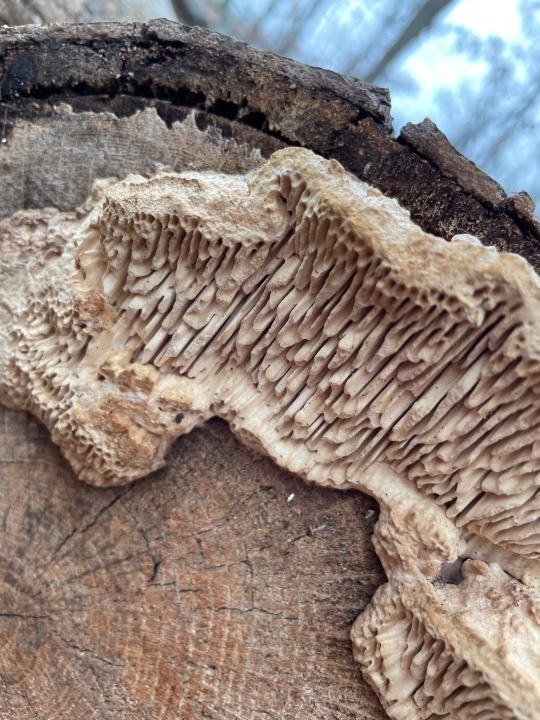

Oak Mazegill (Boston, MA)
>> Daedalea quercina
Saprotrophic fungi found growing on felled oak tree
Observed on: February 12, 2024
#fungi#mushroom hunting#boston#mushrooms#mycology#wild fungi#winter#fungi photography#nature#nature photography#new england#massachusetts
76 notes
·
View notes
Text
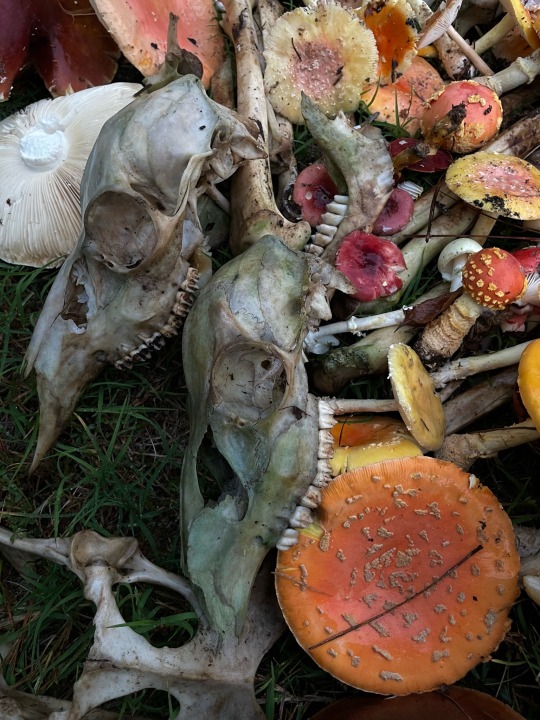

107 notes
·
View notes
Text

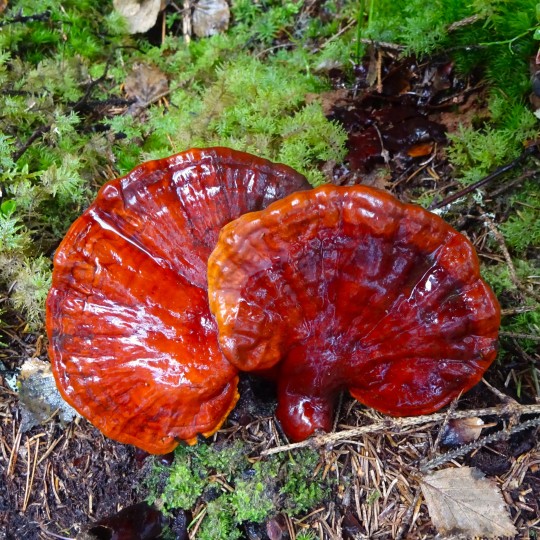
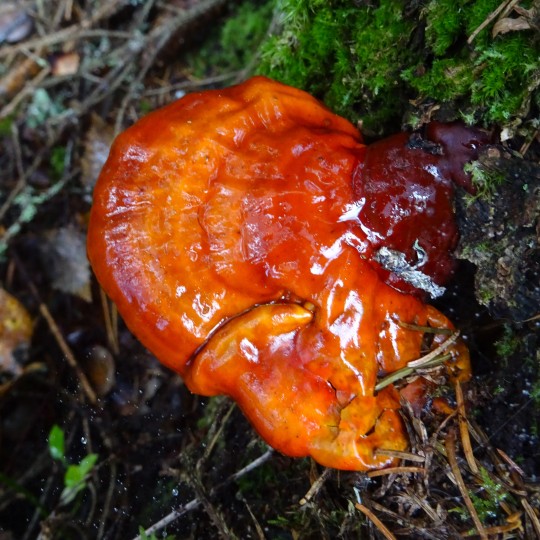




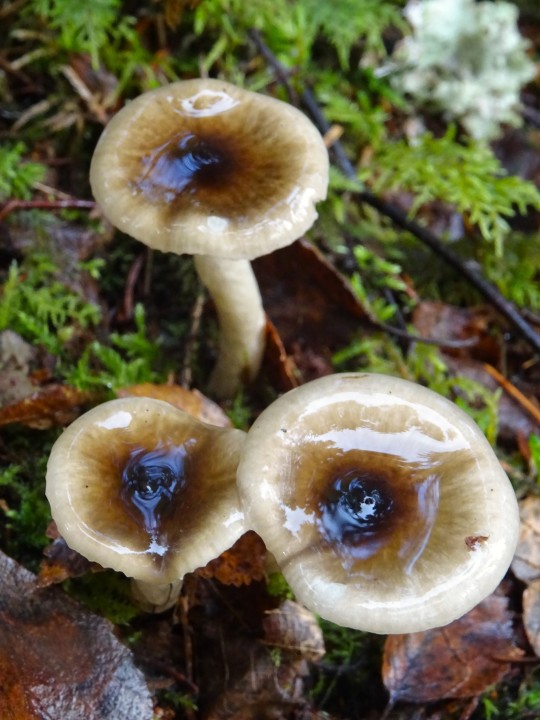
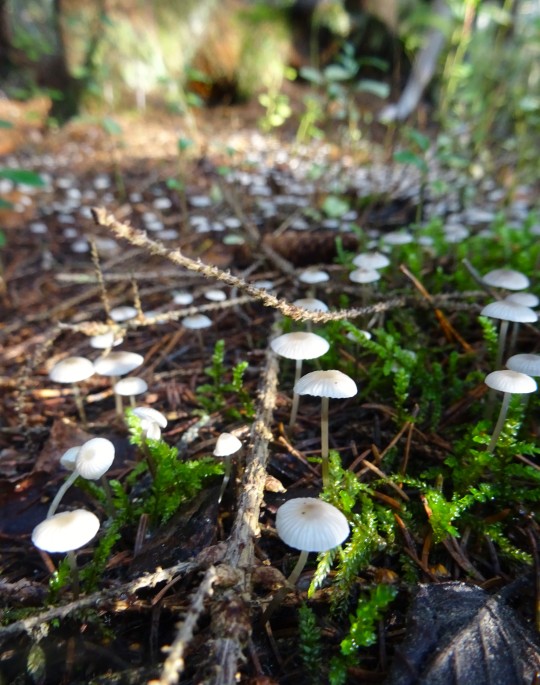
Mushrooms of the day. Saw lots of pretty Ganoderma lucidum!
129 notes
·
View notes
Note
hey there! fellow naturalist (albeit less experienced!) here! in regards to the AI-generated ID guides, do you have any advice for helping the general public learn to recognize them? are there any giveaways other than incorrect information a layperson might not pick up on that we can tell people to watch out for?
Hi, @fischotterkunst! It's a messy topic, to be sure, but here's what I've been seeing of these AI-generated texts, at least on Amazon:
--If you sort your search for "foraging book" or "mushroom hunting" or whatever search string you use by "Newest Arrivals", you'll notice that there is a glut of books that have come out in the past few weeks. Yes, there are always new books, but this is at a higher than normal rate, which suggests AI is behind at least some of them. There ARE occasionally real authors' books that just happened to come out recently, so don't dismiss every single book that is a fresh release. Use the other criteria below.
--They will invariably be self-published or from some publisher with zero online presence. Not a problem by itself; my own chapbooks are self-published on Amazon KDP. But they come out every three months, not every three days, because I am researching, writing, and editing them all myself, rather than churning out content with AI.
--The titles and subtitles are often very long and stuffed with keywords. They are obviously optimized for search engines rather than being descriptive of the book and they have a rather clunky fashion.

--Look for obvious typos and other errors; for example, in the image above we have "WILD MUSHROOM COOKBOOK FOR BEGINNER: The complete guide on mushroom foraging and cooking with delicious recipes to enjoy your favorite". It should be "for beginners", and the subtitle just...ends prematurely. Favorite what? Favorite mushrooms? Favorite cartoon characters? Favorite color? Also, while there are lot of variations on name spellings, "Magaret" instead of "Margaret" stands out as a possible fake in combination with other clues. (All her other books also have this spelling, though.)

--This is a BIG one: Who's the author? Check their bio. In the above image you'll see that "Jason Cones", the author of "The Wild Edible Plants Forager's Handbook: A Beginner's Guide to Safe Foraging, Including How to Identify Edible Plants, Learn About Their Medicinal Properties, and Prepare Them for Cooking", has a very generic picture and bio that has pretty obviously been generated by AI. If you search for him online, the only page for an author named Jason Cones is the Amazon author page--no website, no social media, no interviews, nada. Even a brand new author will at least have something other than their Amazon page, and they'll mention experience, credentials, other biographical info.
--Look at the author's other books. Magaret seems to focus on cookbooks of very specific sorts, but again they've all come out in a very short time. They also tend to often be on really super-specific niche subjects--this, again, is not a red flag in and of itself, but it's a common pattern with AI "authors". Jason Cones, on the other hand, has written over two dozen books not just about foraging but anger management techniques, acupressure, and weed gummies, and all of his titles have come out since last December.

--If all the books have the same cover but slight differences in title, it's also a big red flag. There are reputable publishers of regional foraging guides like Timber Press, but their books are written by multiple authors and have come out over a long stretch of years (plus they're a well-known publisher with a solid track record, online presence, etc.) Also notice the typos in the title and subtitle; everyone says "Mushroom Foraging", not "Mushrooms Foraging", and "Keep Track Your Mushroom Sightings" is missing "of".


--Compare the descriptions of multiples of these new books and you start seeing patterns. If you look at the images above, you'll notice that both Lorna K. Thompson's "Foraging Recipe Cookbook" and Kevin Page's "The Ultimate Foraging Guide for Seniors" have a very similar formulaic description. They start with a brief story about a person in a town or village who discovers some foraging secrets and then transforms his life, and then a list of things you're supposedly going to find in this seemingly miraculous book. This basically reads like "Hey, ChatGPT, tell me a story of a person who improved their life with foraging in two hundred words or less!" Also, the ends got cut off of my screen shot, but they both end with "GET YOUR COPY TODAY!"
I have not purchased any of these books to verify how awful the content is, but what little content I can see in the previews is uniformly formulaic and, again, reads like someone asked an AI to write content on a topic with some specific keywords thrown in. Needless to say, I do NOT recommend any of these books.
Also, I feel really bad for any actual authors who released their books in the past few months. They're likely getting drowned out by this AI junk, though hopefully they're getting enough attention for their work through their publishers, social media, etc. to get some sales. Support your real-life authors, and boycott AI!
Finally, PLEASE reblog this! It's really, really important that people know what to look for, and the more posts we have floating around with this info, the less likely it is someone's going to get poisoned by following what these books have to say.
#fischotterkunst#AI#Ai sucks#chatgpt#foraging#mushroom foraging#mushroom hunting#wild foods#nature#mushrooms#plants#fungus#fungi#books#self publishing#Amazon#PSA#poisonous mushrooms#poisonous plants
554 notes
·
View notes
Text
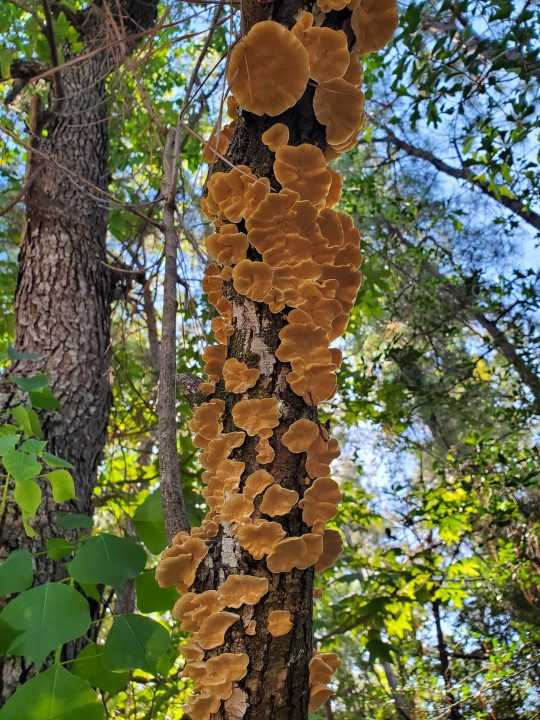

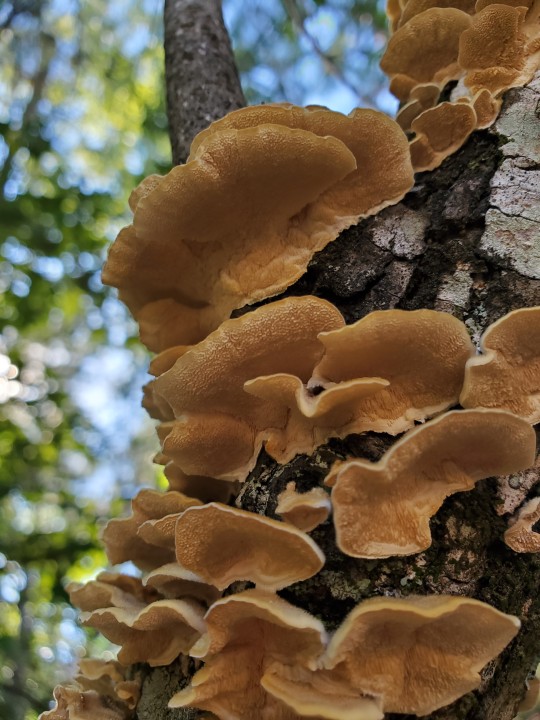


Ochre bracket 》 Trametes ochracea
This group is so pretty! Caught my eye as I made my rounds to check on the honey clusters.
Southeast Texas, 15 Nov. 2023
#amatuer mycology#mushroom hunting#mushrooms#mycology#wild fungi#fungi#mushrooms of texas#texas mushrooms#fungi of texas#fungarium#wild mushrooms#mushroom#bracket fungi#foraging#mushroom identification#ochre bracket#special interest#polypore#polypore mushroom
169 notes
·
View notes
Text

Laccaria amethysteo-occidentalis
#Laccaria amethysteo-occidentalis#laccaria#mushrooms#mushroom#fungus#fungi#mycology#mushroom hunting#nature#camping#outdoors#amethyst deceiver
225 notes
·
View notes
Text
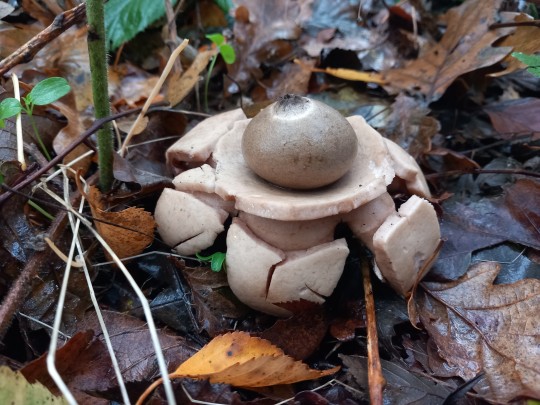
Lincolnshire, UK, Novemeber 2023
Collared earthstar (Geastrum triplex)
These gorgeous fungi emerge initially as a globe-like fruiting body consisting of a spore sac (the bulbous part on top) and an outer layer that will quickly split and spread outwards, pushing the spore sac higher and forming the star shape underneath. These fungi are known as 'collared' because of the 'arms' of this species having a tendency to crack as they bend backwards, forming a sort of 'collar' that the spore sac sits on, as you can see in this photo.
#fungi#mushroom hunting#inedible fungi#earthstar#earthstars#collared earthstars#mycology#geastrum#Geastrum triplex
134 notes
·
View notes